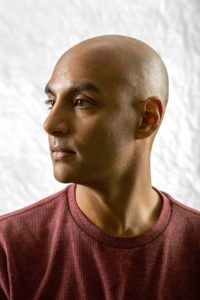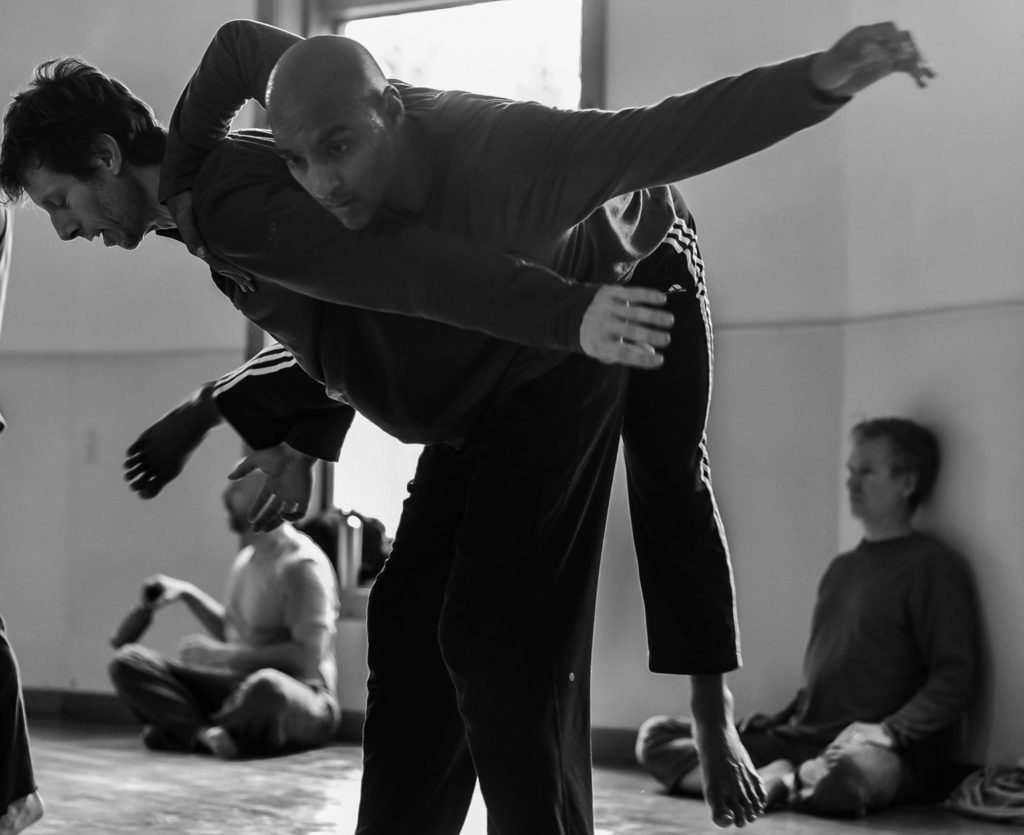
The main form of dance I practice as of late is Contact Improvisation (CI). The name tells you everything: you are improvising while in contact with another person or group. And in truth, by the very nature of the form, there is nothing more dangerous that could have been practiced in these past two years. To be in proximity to others is what creates the craft. To barrel into someone else’s limbs. To crumble your architecture next to another person’s collapsing structure. To reach out and add yourself to a friend with a hand that asks for nothing. All we do when we practice this form is focus on making a dance that can be found. How can I be approachable while maintaining my own agency, my own interest? How can I hold those two opposing centers of concern and balance them out equally in time to share my sense of control with the weight of a person I’m just meeting in the space?
It is by far the most improvisational, alive-ning form of movement I’ve ever met. I take it and use it to feed the other forms of dance I have to maintain to make a living – ballet, Yoga, experimental, teaching. I lean on it to make me feel special. Every so often it betrays me. It asks me at every moment to temper my ambition with curiosity. It moves into directions of safety, anxiety, and pleasure all at the same time. It helps me negotiate my surroundings. It forces me to be a better human. As I write this, I realize it is the relationship in my life I understand most, even when I am lost in it.
CI obliterates all expectations. Any moment you try to make something happen without considering your partner (or everyone in the room for that matter), you set yourself up for disaster. When you hold an expectation up against someone, you rob both of you of the present moment that could have been. That’s not to say that you can’t have ambitions, you can’t make attempts, you can’t really go for something and be satisfied. You just have to do it with your partner in mind.
Now the problem is that this form of dance needs us to be right next to each other. Leaning on each other. Sharing enough weight to say, “if you left, I’d fall.” Because this is what makes this kind of dance limitless as it dives into the unknown – you have to react to the reality of your instincts blended with everyone else’s instincts, and somehow survive in this new constantly shifting world. This alive, chaotic, fulfilling place was one of the first parts of my life to vanish during the pandemic. So what am I supposed to do when the one activity that grounds me is deleted? I’m not sure. I grieve it. Though I understand that to lose this is miniscule in comparison to losing a job, a home, a loved one. But this form is also my greatest teacher, and without it, I haven’t been able to accept the events that have shaped this country for the past 24 months.

My family is Indian. I am first generation. First one of my family born in the states. And try as I might to look like everyone else while passing through adolescence, the giveaway was always at the surface of my skin. I’ve learned to question my color, condemn it, resign to it, and slowly accept it. Someday I hope to celebrate it. I am the son of immigrant parents. And so, I grew up with their wisdom in my ear. They could feel unrest before they had to see it splashed across a banner headline on the local news. They watched it happen in their home country, and so upon arriving here, could see it coming in a hazy premonition, like an unnerving crystal ball. I’ll never forget my mother’s words one evening after Obama was sworn in: “You wait and see. When he leaves office, you’ll see the surge of racial unrest rise again. It’s a tide that’s always just under the surface.” I didn’t really hear her in that moment until I saw it for myself 8 years later, her timing so precise it made me fully understand the doom of repeating ourselves.
CI has always kept me sane when sanity becomes a luxury instead of a fundamental component of our daily operating lives. I hide in it. And I escape in it. It allows me to pretend the bad isn’t happening, at least for a few brief hours in the week. It’s pure hypocrisy if I look at it objectively: a kind of dance I love that doesn’t love me back. A room full of white people dancing with me as the only outlier. “Do the work” I tell myself. It doesn’t matter if I’m queer, brown, cis-gender, or small in size. Do the work. But as inclusive as CI is, it is never lost on me the differences I embody.
Can good dance come out of a body of color? Do people change the lens with which they watch brown skin moving? I am actually saying that I have to worry that Brown skin is a handicap. This scares me. It infuriates me. It also spurs me into action.
So, CI is my way to take in and accept the nonsense that is this country right now. It is the way I learn to forgive, exist with the news reports, keep my instincts up around me when navigating NYC. And without it these last years, I have hardened.
It frustrates me that we, as artists, have to claim vulnerability as the way to being fully actualized. The super key to our superpower. It is the way to create connection to our inner selves and then share it with others. But to be vulnerable, to be in a state of emotional or physical exposure that comes with a certain degree of uncertainty, is hard enough in a studio. I can’t claim that vulnerability in the world around me, not in this current world. I don’t feel any permission to use that superpower right now. I don’t feel safe enough to be an ambassador of art. It is hard enough inherently being an ambassador of Brown.
Every generation has its marker, its reminder of racial tensions. For me, I can’t see past Ahmaud Arbery. I thought Sandra Bland would halt me. And then I thought Philando Castile would derail me. But it is Ahmaud that finds me on a couch late at night right before I realize I’m exhausted and need to go to bed. It’s then that I feel that rush of wet behind my eyes, that stinging that overwhelms me because I can imagine being him. I can imagine being yelled at and chased and turned into prey just because I like to run but forgot that running is a privilege. That certain areas, neighborhoods, parts of this earth, are only meant for people that look a certain way. I sheltered in a rural, western, conservative part of a midwest state during the pandemic. Ahmuad was murdered during this time. With no physical practice at my disposal, I had gone back to running to stay active. But there wasn’t a day that went by that I didn’t find myself jumping off the road into a ditch any time I felt a pickup truck revving from behind. After having clocked the number of 45 flags I would run by, I could feel myself shrinking, as if I was the one causing trouble. It made me quiet. And I’ve spent a lot of my life quiet. Always trying to read the rooms I’m in to see if I get mistaken for an ethnicity that is generally accepted in the space.
So, the two things that ruled my world these past years are the lack of the practice that gives me courage and experiencing the lethal mistreatment of an innocent man of color. CI and Ahmaud. And what I’m left with is thinking that my faith in CI’s principles could have helped me process Ahmaud. Helped me remember that there are forms and practices out there that accept all parts of all people: emotions, colors, desires, abilities, boundaries. But with a tragedy this potent I fear even more that even with CI in my life, it would have done no good.
And then I’m left with this bigger question of “Can dance save me?” I don’t want it to just be a tool to process pain. I want it to be a vehicle for radical change. And that just asks too much of it.

So, what am I asking for? At the end of this day, today, Thanksgiving, I am asking for a deliberate kind of attention. It is what is necessary for CI as practice. When we are dancing in a room full of people, you have to manage your own ambitions, the expectations of your partners and the room as a whole. You have to take the time to warm-up and get to know yourself, so that you can be added to a bigger whole. I want this deliberate attention when I live in the world. I want to enjoy and accept my own company and be open and available to all that enter my path. I want to be able to say no when I need to. And walk away from situations I cannot fix, change, or heal. The tenets I apply to CI are aspirational: to not care about your dancing history, your ableness, or the color of your skin. To only care about your willingness to listen. Your ability to move at the speed of attention. However, I can’t make this translate to the larger world anymore. I could once, but I can’t make it happen at present. I want that back. And it will come. When we get back to the physical practice, it will come. It has to. Because in the interim, my defenses have bolstered. I worry, I harden, I see danger and miscommunication everywhere. And I see the end results of these fears in what happened to Ahmaud. But I live hopeful that CI can help me return to a place of sanity, acceptance, and perhaps even trust again.
This article appeared in the Winter 2022 issue of In Dance.

